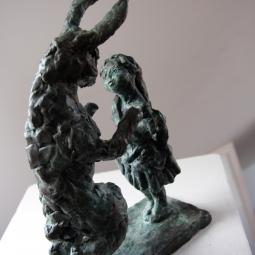Biography
Magic Realism originated in Latin America and took shape through the 20th century in literary and artistic contexts. It is characterized by its realistically rendered world, to which Mythical and Magical elements are added, elements that question the reality that we perceive as ‘real’. The Magic elements are often seen as supernatural or unrealistic, thus, a connection and a dialogue is established between two worlds - the realistic world and the unreal, magical world. And precisely because Magic Realism positions itself between the real and the unreal, the artistic expression bears a duality and a depth, that allows for many different statements and interpretations.
Elements from fairy tales and magic flourish in the sculptures of Helle Rask Crawford. Helle’s diverse artistic background including croquis, drawing and painting, is a strong point in her sculptural facets, portraying both man and animal, demanding an extensive understanding of the intrinsic proportions and movements of the body. Prior to the completed sculpture, lies a comprehensive process wherein the idea is visualized and given a physical form. This extensive process of creation and the melting and pouring of metal, can be said to constitute the life-giving aspect of her sculptures. Presence and vivacity are felt in the sculptures through the movement and the interaction of the figures, as we see in “Frog!”, where the frog throws its tongue far and wide in the direction of the naked woman. Even though Helle’s sculptures are naturalistic, the stories told by her sculptures, and the combination of human and animal, quickly reveal themselves to be unreal, as seen in “BeetleSurfer”, where the little boy rides a giant beetle. An expression like this adds humour, another typical trait of Helle’s art. The humouristic element is an important feature, which has the effect of immediately establishing a bond between viewer and sculpture, inviting you to join them on their adventure and be part of their story, as seen in the exchange taking place between the two bird-figures in “Fowl Play”
By Nina Sølbek Pinderup, student of Art History and BA in Visual Culture from Aarhus University.






